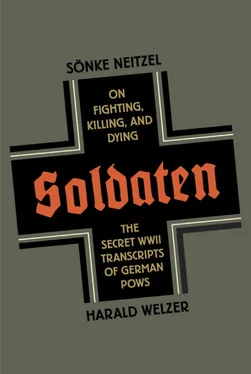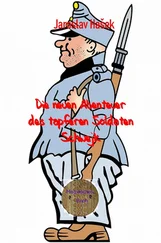In the earliest phase of World War II, without having been brutalized himself by previous events, Pohl perpetrated a kind of violence that could hardly have been more brutal. Pohl’s individual motivations notwithstanding, such senseless hunting down and killing of people is a perfect example of what German sociologist Jan Philipp Reemtsma called “autotelic violence”—violence committed for its own sake without any larger purpose. {87} 87 Jan Philipp Reemtsma, Vertrauen und Gewalt: Versuch über eine besondere Konstellation der Moderne (Hamburg: Hamburger Edition, 2008).
Reemtsma distinguished this type of physical violence from attempts to eradicate people because they represent an obstacle to a source of personal gain. Those are practical, instrumental motivations which, moral scruples notwithstanding, are easily comprehensible. Autotelic violence, on the other hand, challenges our powers of comprehension since it radically contradicts the civilized self-image maintained by modern societies and their members. It undermines our faith in the stability of our institutions and rules and, above all, in the state’s monopoly on the legitimate exercise of force. “Faith in the modern age,” writes Reemtsma, “is unthinkable without the state monopoly on force.” The truth of this statement becomes self-evident when we imagine the carnage that would ensue if the protections offered by modern rule of law were suspended even for a single day.
Such faith is the basis for what modern individuals like to believe is their own distance from violence. Violence is considered the exception to the rule, and when it does occur, we seek explanations, even in cases where no instrumental motivations are apparent. By contrast, those who do not assume they will be physically protected constantly reckon with the possibility of violence and are not shocked when it occurs. Faith and violence exist in a precarious equilibrium. In our world, “senseless,” “unmotivated,” or “raw” violence has to be immediately characterized as “insanity,” “rupture,” and “barbarism”—i.e., the antithesis of modernity. For this reason, sociological and historical research on violence is accompanied by subjective moralism and often encounters serious difficulties. {88} 88 Harald Welzer, Verweilen beim Grauen (Tübingen: Edition Diskord, 1998).
From a broader historical perspective, the modern age is the first time in which violence has been considered the antithesis of civilization, something to be suppressed and battled against. Violence, in and of itself, must be contained. Instrumental violence cannot, of course, be entirely prevented, but we can justify or at least explain it. We consider the use of violence to solve problems normal, whereas using violence for its own sake is pathological. Violence is a sign of someone straying from the path of modernity, indeed heading in the opposite direction. Nonetheless, as our most recent wars illustrate, {89} 89 Mary Kaldor, New and Old Wars: Organised Violence in a Global Era (Cambridge: Polity Press, 2006); Herfried Münkler, Über den Krieg: Stationen der Kriegsgeschichte im Spiegel ihrer theoretischen Reflexion (Weilerswist: Velbrück, 2003).
violence is in no danger of extinction. Paradoxically, we can only maintain our faith in modernity if violence is not considered part of the normal daily functioning of modern society. For that reason, we see ourselves as nonviolent, and ostentatiously demonstrate our shock when an act of violence is committed and immediately begin searching for explanations.
The sort of autotelic violence committed by Lieutenant Pohl, however, needs no motivation. It is a reason unto itself. Within a universe of purpose-driven rationality and the universal imperative to justify social behavior, autotelic violence is an erratic exception, unlike everything else in the social realm. But this view may be irrational. Do we feel the need, for instance, to account for the human sex drive? Do we try to explain why human beings eat, drink, and breathe? In all these core areas of human existence, questions may arise as to how people try to satisfy their needs. But we never question the fact that human beings want to eat, drink, breathe, and have sex. Inquiries in those areas focus on mode, not motivation, and perhaps it would be better to do the same when confronting violence. Violence, as German sociologist Heinrich Popitz proposed, is always an option in social behavior, and in phylogenetic terms, this could hardly be otherwise. Ultimately, the human race did not survive thanks to its peaceful demeanor, but because of the violence it committed when hunting or fending off competition for food.
The state’s monopoly on the legitimate use of force in Western societies may arguably be the single greatest civilizing innovation in human history, creating previously unknown levels of personal security and freedom. But that doesn’t mean that violence has ceased to be a social option. In being transferred to the state, violence changed form, but did not disappear. On the contrary, violence can be converted back to its direct form at any time. Moreover, the state monopolization on force may regulate the central realm of society, namely, all matters of public concern, but by no means does it cause violence to disappear from other segments of society.
In the domestic realm, people continue to use violence against their partners, children, and pets, and violence occurs frequently in relatively isolated social realms like churches and boarding schools. Fistfights and attacks are still common in public spaces like sports arenas, nightclubs, bars, and subways as well as on the street. In addition, there are regular forms of organized public violence beyond the state monopoly, for instance, at boxing or martial arts contests or performances in S&M clubs. One need only to take a drive on an ordinary highway to experience the chronic potential for violence and even homicide among perfectly normal people. It is impossible to imagine television, cinema, or computer games without violence. Indeed, as everyday reality increasingly distances itself from violence, our need for symbolic or compensatory acts of violence may even be growing. And internationally, humankind is far removed indeed from any sort of monopoly on force. States still wage war, no matter how problematic that might be for relatively pacifist societies like contemporary Germany.
In other words, violence has by no means disappeared from societies that consider themselves fundamentally nonviolent. It exists at all times as both a fact and a possibility, and as such plays a major role in human imaginations. That, too, is a kind of presence, even in situations where violence would seem to be absent. If we rewind history seven decades, back to the point when Pohl and Meyer’s conversation took place, and consider how much closer to violence people were back then, we will realize that exercising and suffering from violence was something many people experienced on a daily basis. Corporal punishment and severity were the norm in the Wilhelmine educational system of the nineteenth century. Indeed, they were considered not only permissible, but essential to a child’s proper upbringing. {90} 90 One of the most prominent and frequently read works of this sort is Johanna Haarer’s Die deutsche Mutter und ihr erstes Kind (The German Mother and Her First Child). It was first published in 1934 and was reprinted after the war without the word “German” in the title.
The educational reforms of the early twentieth century were nothing more than a reflexive response to this phenomenon. Violence continued to feature in German educational institutions of all levels as well as in agricultural labor and trade apprenticeships.
Читать дальше












